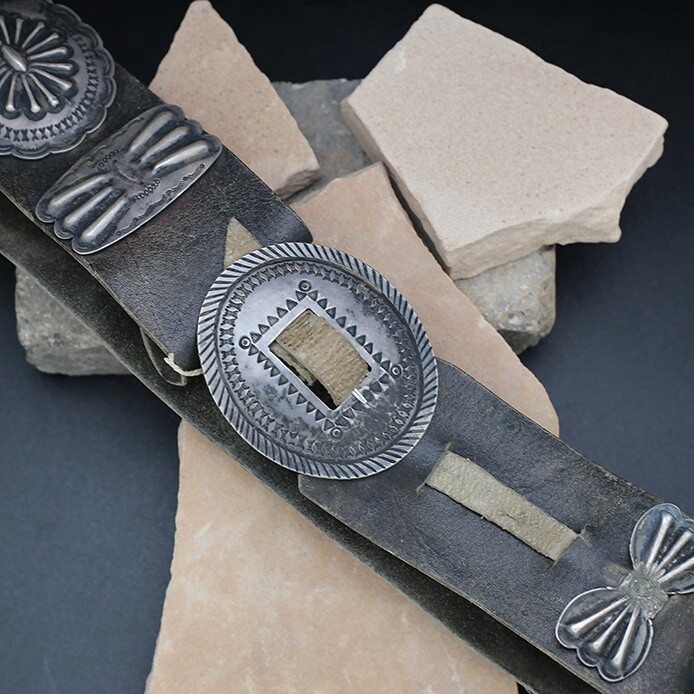Third Phase Concho belt on leather
This is a uniquely styled belt and some what eclectic in its design. The belt has concho's, in which some of them look to have had stones mounted in the center of them at one time but seem to have been removed at some point in the life of this piece. All the concho's and butterfly's are mounted on the wide piece of leather and are tied on underneath making them look like they are resting on the wide 2-1/4" leather belt. The concho's measure 2-1/4" x 2-3/4" and the butterfly's measuring 1-3/4" x 2-1/4", the buckle is a 3" x 2-5/8" oval. The belt has 36" of total length.
Concho Belts The word concho, sometimes spelled concha, comes from the Spanish word meaning shell. Some of the first "conchos" were made of melted silver dollars and resembled a shell—it is commonly thought this is how the name came about. In Spanish, the correct word is concha, with an a at the end and is pronounced like an ah sound. However, most people now-a-days refer to the Native American style belt as a concho belt, with an o. Although it is commonly said the Navajo (Dine’) borrowed the idea from Spaniards, the Concho Belt has become a long-standing Native tradition. Concho Belts reportedly began appearing in Navajo country in the late 1860s or early 1870s. The Navajo (Dine') learned how to work silver in the mid-nineteenth century. They had long appreciated silver jewelry that they acquired from Southwestern Hispanics and Plains tribes, but it is generally believed that they did not learn how to make metal jewelry until circa 1850 when Atsidi Sani became friends with a Mexican smith named Nakai Tsosi. Tsosi taught him how to work iron so that he could make bridles that he could sell to other Navajo. After the end of the Navajos' internment at Bosque Redondo near Fort Sumner in 1868, Nakai Tsosi taught Atsidi Sani how to smith silver for jewelry. He, in turn, taught his sons and other Navajos.
"Third Phase" of concho belt development, you started to see the "butterfly" appear between conchos and also the use of turquoise as an adornment on the face of a concho. A "butterfly" is simply another smaller concho in between the bigger conchos and its shape somewhat resembles that of a butterfly (a bow shape). Copper for the strap across the back becomes more prevalent than a silver bar as you go further on in time also. A belt with butterflies (and sometimes turquoise) from the early 1900s through the 1930s is generally thought of as "early third phase" and a belt from the 1940s through 70s (or so) would often be referred to as "vintage" while anything newer would be modern to contemporary.

